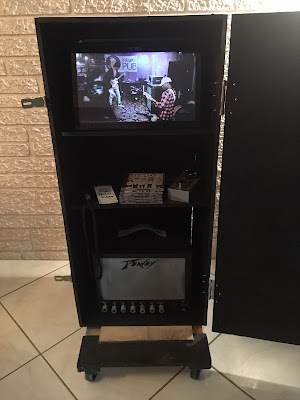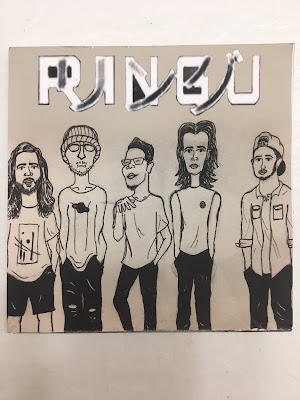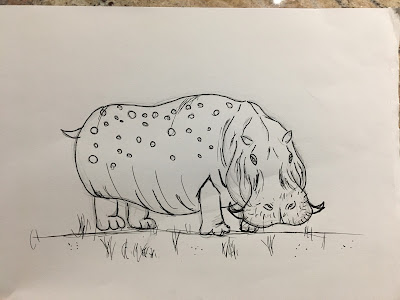After many ideas and attempts to start the In depth project, I took a step back and I thought about my brother in California and the Thomas Fire that is happening around Santa Barbara. Many people have lost their homes and relatives, as well as a few vineyards that also got caught in the fire. And of course I wanted to also commemorate the firefighters that risk their lives everyday to have control over the fire.
Tuesday, December 12, 2017
Monday, December 11, 2017
Topic #6 The Art Universe and Miami Art Week
Enjoying some ginger spiced pineapple juice at the Casa Lin during Art Basal weekend. Amazing artwork, food, people, and atmosphere.
Monday, November 13, 2017
Topic #5 Telling Stories Rothman Reading
I really like Marion Fayolle's "The Mirror." To
me, it shows a man walking up to the mirror admiring himself which maybe gives
a narcissistic expression on the character. Then you see a woman who sees the
man looking in the mirror and she appears to show some anger or jealousy and
throws the stone at both the man and mirror. She gets other women to help her
collect the broken glass and they all use the fragments to make artwork.
I
think this expresses how the woman felt angry that the man was so intrigued by
himself instead of the woman so she used the stone to get rid of the man and
used him for her art piece to tell a story. I really like it because its a
visual story without words. Words would tell you exactly what is going on but I
think the artist doesn't add text for a reason. She wants us to know ourselves
just by looking at the images and she wants us to tell the story.
Topic #4 Landscape In- Depth Project
For my topic #4 In-Depth project, I constructed a mirror image of two similar houses, ponds, walls, and landscaping. I wanted to convey how pollution or non-extensive care could spread in the environment. The left side shows a home that is well kept in an eco-friendly setting where the grass is well cut and fed, the pond is filled with clean water and the walls are clean of graffiti. The right side shows a home that is rotting from neglect in a polluted setting where the grass is not cared for and the water is contaminated and the walls are full of graffiti.
What makes this piece interactive is not only the real water in the ponds but the mirrors that are hidden underneath the broken brick wall on the polluted side of the project. If you adjust ur eyes on the eco-friendly setting while hovering over the polluted setting, the mirror shows the eco friendly setting turning into the polluted one. This gives reference of how pollution can easily take over without extensive care and awareness of the population.
The materials that were used for this project are wood, popsicle sticks, moss, glass, paper, paint, rocks, sand, plastic, and makers.
Saturday, November 11, 2017
Small Work #3 Cavilino City Critique Method in Class
The materials that have been used in this display are Rope, Glass, Wood, Burlap, Cork and Thread.
The burlap sack gives reference to Euphemia being that it is a material used for packaging goods and used for trade. The bottles give the reference of the people coming from all over to the sea port. The wood gives reference to the ship that comes to the port to unload the cargo for the port.
- The materials bring a sense of Market and trade as well as social aspects.
- The mood gives a social location and the sense of location says a sea port or market place.
- In reference to the text the Burlap sacks represent the cargo of nuts, poppy seeds and other goods being traded into the port. The wooden box gives reference to the merchants and the bottles with rolled up paper represent the stories and social aspect of the people that gather to share memories with each other.
Topic #4 Landscape Additional quick research to accompany your reading of Eccentric Spaces












Monday, October 30, 2017
Morikami Museum Visit
The Morikami Museum was so beautiful. I remember very little about my first visit when I was about 5 years old and it was such a refreshment and it was like seeing the garden for the first time again. The weather was crisp. The garden was peaceful and calm. We got there right when they opened so there wasn't a lot of visitors which made the garden almost a private experience. The landscaping and the weather at the time made me feel like I time traveled to Japan in a split second. Everything was just perfect!
Small Work#1 Garden
For my small work assignment I chose Treetops park in Davie, Florida for my 30 minute writing and drawing. After walking a small trail in the middle of the park I captured this scenery of a quiet calm lake. the weather was cool and the sky was clear. The lake was filled with catfish, turtles, alligators and you could even see quite a few ducks as well. It was very serene and peaceful.
Monday, October 23, 2017
Small work topic #4 Poetry
Serene lake
Walking the end of a breathless take,
Approaching the beginning of a clear serene lake,
Vibrations of wind, birds, water, and hushed cars,
how I wonder what it's like being here with the night stars.
A surface roofed with Lillies, trees, and bush features,
In the water lies catfishes, turtles, ducks and other living creatures.
The scent of clear air, flowers, and fresh pine,
a place so peaceful a place of sublime.
With open fields and woods condense,
The grass is rich in color and clearly immense.
The sky, vast and partially clear,
Clouds of cirrus and stratus I spot from the pier.
As the wind softly blows the surface with tension,
the water is still clear you can see another dimension.
As I leave, my last breath I take,
I long to come back to the beautiful, quiet, serene lake.
Wednesday, October 18, 2017
Tuesday, October 17, 2017
Propaganda Portrait
For my in-depth project I drew Gordon Ramsey as an admirable portrait using white and black charcoal. The left portrait is the admirable and the piece on the right is the propaganda portrait depicting a workplace bully. I had a lot of fun with this project considering that I highly admire Gordon Ramsey.
Monday, October 16, 2017
FIU Frost Museum
Lewis Hine's "Little spinner in mill" shows a young girl in a mill factory. By observing the piece, you can see the mess on the floor and you can depict that the girl was working in poor working conditions and how dangerously close she is to the machines. You can even see that her shirt is stained and worn out from her working in the factory and by the look on her face I wouldn't guess that this was a dream job of hers.
Thursday, October 12, 2017
In Depth Project : Abstraction of the Form
For my Pattern and Ornament In-Depth piece, I made a charcoal and fabric based drawing using a 6ft x 3ft brown paper and I used drum sticks, and red ribbon as the support. This Japanese inspired piece presents an Oni mask and a Tengu mask both used for protection against evil spirits, aid for good luck, and celebratory attire. The Japanese writing on the top right corner translates to passion in which I used passionate as my personality trait for the piece. In relation to the ornamental chair, the skin of the dragons represent the cushions of the chair. The spikes on the spine represent the tuners on the bass guitars from the chair, and the Oni and Tengu masks represent my appreciation for theatre.
Wednesday, October 11, 2017
The Rhinoceros from Durer to Stubbs 1515-1799
I prefer Durer's woodcut compared to Burgkmair because to me it had more exaggerated features making the rhinoceros more unique and interesting to the eye. Durer also had studied armor in which you can see the influence from that in the woodcut giving the rhinoceros a remarkable appearance.
I really like the olive-green chiaroscuro woodcut of Durer's rhinoceros because there is an extensive amount of detail in it. I can see a lot of sharp marks as well as soft marks that have been made in the piece. Because Durer was influenced by amour, I can also see how the plates on the rhinoceros show a lot of similarity to that of Durer's influences. I can also see an exaggeration on the rib cage and how it resembles like the pegs in an umbrella giving the rhinoceros a striking appearance.
Tuesday, October 10, 2017
Sunday, October 1, 2017
The Wolfsonian-FIU,
At the Wolfsonian, out of all the amazing pieces that I saw, there was one piece that really stood out to me. This oil painting was made by Dutch artist, Harald Rudyard Engman in 1941. His subject was an Anti-Nazism , Humor/Satire , Figurative piece and it is about Engman's commentary on the negative aspects of Nazi occupation of Denmark during WWII. The painting has a human pyramid made of different time frames and on left shows Denmark in the past and on the right shows Denmark in the present during WW II.
Here is Ethel Magafan's
Andrew Jackson at the Battle of New Orleans.
This piece is depicting the building of bulwarks by
slaves piling up cotton bales.
Subscribe to:
Comments (Atom)





































